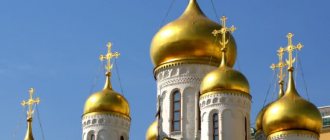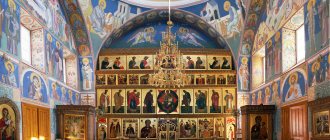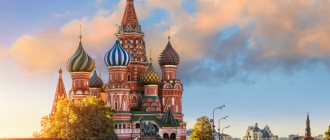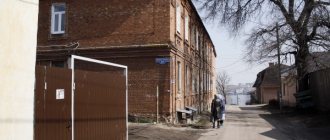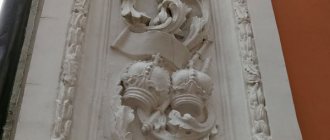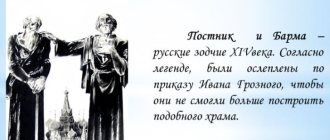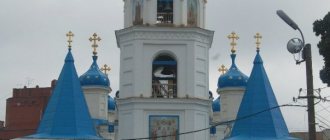Russian Old Orthodox Church (“Novozybkov hierarchy”)
, one of the Old Believer organizations of the priestly persuasion.
The basis for the Old Orthodox Church was the Beglopopovites, who did not accept the Belokrinitsky hierarchy. A significant part of them in 1923 recognized as their head the Saratov Renovationist Archbishop Nikolai (Pozdnev), who had come to them.
In September 1929, they were joined by the Josephite Bishop of Sverdlovsk Stefan (Rastorguev). Literally a few days later, Bishops Nikola and Stefan already consecrated the new Bishop Pansophius.
Since 1923, the head of the newly formed church was called the Archbishop of Moscow, Saratov and All Russia of the Old Orthodox Christians
.
Initially, the center of the church was in Saratov. In 1924, it was moved to Moscow (at the St. Nicholas Church at the Rogozhskoe cemetery), and in 1955 to Kuibyshev (Samara), and finally in 1963 to Novozybkov (Bryansk region), which is why the church is often called the Novozybkov Archdiocese.
The Transfiguration Cathedral in Novozybkov was closed only in 1938, and in 1943, during the German occupation, services there were resumed and never stopped.
On March 3, 2002, the Council of the Ancient Orthodox Church ended, at which a decision was made to restore the patriarchate. Archbishop of Novozybkovsky, Moscow and All Russia Alexander (Kalinin) was elevated to the rank of patriarch with the title “Old Orthodox Patriarch of Moscow and All Russia”
.
Church history
The basis of the Old Orthodox Church was originally made up of the Beglopopovtsy. This is part of the Old Believers who accepted the priesthood passing from the New Believers Church. However, they did not recognize the Belokrinitsa hierarchy.
In 1923, the majority of members of the Old Orthodox Church recognized Saratov Archbishop Nikola as their head. His contemporaries noted that the already elderly monk Nikola quite unexpectedly switched to the renovationists. Many even believed that he was out of his mind. He became disillusioned with the Renovationists after about a year, but did not return to the Russian Orthodox Church, but switched to the Old Believers.
In 1929, another famous clergyman, the Bishop of Irginsky, joined the Old Orthodox Church.
Old Believers Center
Initially, the center of the Russian Old Orthodox Church was in Saratov, but in 1924 it moved to Moscow. Became based at the St. Nicholas Church at the Rogozhskoe cemetery.
In 1938, the Transfiguration Cathedral in Novozybkov was closed. Divine services there were resumed only during the years of German occupation. Since then they have not stopped. But still, in 1955, the center of the Old Believers, to whom this article is dedicated, returned to Saratov.
REFERENCE: Russian Ancient Orthodox Church - RDC (“Beglopopovtsy”, “Novozybkov Hierarchy”)
By the beginning of the 18th century, the Old Orthodox Christians (Old Believers) were mainly divided into Bespopovtsy and Beglopopovtsy, also called simply priestly. One of the main reasons for the division was the question of the possibility of accepting “in existing rank” the so-called “fugitive priesthood,” that is, clergy ordained in the official New Believer Church (that is, “Nikonians”).
The Beglopopovites, although they tried to maintain prayerful communication with each other, were not internally completely united: the “liberal” part stood out, the Dyakonovites, who believed that from “Nikonianism” it was possible and even desirable to accept “fugitive priests” and, ideally, a bishop as a “third rank” , through repentance and renunciation of “Nikonianism”. The rest, the majority, of the Beglopopovites considered it necessary to have a “second rite,” when a clergyman transferring from the Synodal Church was accepted not only through repentance and renunciation, but also through the anointing of pre-schism sanctification with myrrh.
Initially, the spiritual center of the Beglopopovites was Kerzhenets, but after its destruction under Peter I by Archbishop Pitirim, the spiritual centers became Starodubye, Vetka, the monasteries of Irgiz and Veselye Gory (Ural), as well as Beliva (Moscow region). The importance of the Gorodets Chapel was also great for the Beglopopovites.
During the second half of the 18th - first half of the 19th centuries. There is a gradual radicalization of the majority of the Beglopopovites in the Urals, Siberia and Altai, and by 1840 they ceased to accept “fugitive priests” in general, while maintaining many Beglopopovsky views - a chapel agreement appears, separate from other Beglopopovites. In 1800, with the establishment of Edinoverie, part of the Beglopopovites, in particular a significant part of the Dyakonovites of the Starodub Sloboda, joined it. In 1846, the most significant division took place among the Beglopopovites, associated with the acceptance of the retired Metropolitan Ambrose of Bosnosaraevsk as the “second rank” in Belaya Krinitsa - the Belokrinitsky hierarchy appears, which part (at least more than half of all Beglopopovites) recognizes, and part (led by authoritative and popular among the deacons, a priest from the former “fugitive priests” Pavel Tula) - does not recognize. This actually marked the beginning of the existence of the RDC in the current sense.
At first, the RDC was often called the “Tula Consent,” although the familiar term “Beglopopovtsy” was also used. Accordingly, the city of Tula, and then the Volga cities of Volsk and Gorodets, were of particular importance for the agreement. The authorities pursued the “Tula Consent” somewhat less than, for example, the Belokrinitsky hierarchy or the Fedoseevites, since it was considered more “moderate”, and, in addition, even more “moderate” Dyakonovites took a noticeable part in its formation, who ceased to be a separate consent ( almost completely becoming part of the RDC and Edinoverie). For example, the police authorities had to take into account the “unspoken opinion” of Chief Prosecutor Konstantin Pobedonostsev that priests who went over to the Beglopopovites should not be persecuted. He did a lot for harmony at the turn of the nineteenth and twentieth centuries. Nizhny Novgorod “millionaire” (millionaire, oligarch) Nikola Bugrov, so after his name the RDC at the beginning of the twentieth century. was often called the “Bugrovsky agreement”.
At the beginning of the twentieth century, both before and after the October Revolution, congresses (for example, in Volsk) of laity and clergy were held, and research was undertaken for the bishop. After 1917, among the highest clergy of the Russian Church, and after its division both among the Tikhonites and among the Renovationists, the opinion spread about the possibility of “granting” a bishop to the Beglopopovites. Some of the bishops even received a blessing for this “gift” - for example, Andrei Ufa and Tikhon Uralsky. Andrei (Prince Ukhtomsky), Bishop of Ufa, known for his sympathies for the Old Believers, claimed that he received such a blessing from Metropolitan Anthony (Khrapovitsky) and Patriarch Tikhon (Belavin) himself. But ep. Andrei became interested in his participation in the White movement, and in general the Civil War made adjustments to these plans. In 1923, a significant part of the Church members recognized Saratov Archbishop Nikola (Pozdnev), who had transferred to the RDC, as their head.
In 1924, in exile in Ashgabat, Andrei (Prince Ukhtomsky) ordained a certain “fugitive” Archimandrite Kliment (Loginov) for the RDC as bishop, but at that time Andrei Ufimsky was in rather bad standing with the authorities, and Nikola (Pozdnev) was preferred to his protege. . Nevertheless, perhaps embarrassed by the “renovationist episode” in the biography of Nikola (Pozdnev) and his “promise” given to his former clergy during the transition to “bring his future flock into unity with the Church,” the Beglopopov leadership looked for other bishops to “strengthen the hierarchy” . For a short time, the Sergian Bishop of Zvenigorod, Philip (Gumilevsky), came to them. Negotiations are underway with the Sergian Synod, in which Juvenaly (Maslovsky), Archbishop of Ryazan, is participating on its behalf. They reached an agreement on the “transfer” of four more bishops to the Beglopopovites. But, obviously, the possible danger of “loss of identity”, and, most importantly, the lack of urgent need, prevented this, because in September 1929, the “Andreevsky” (installed by the bishops who recognize and remember Andrei (Ukhtomsky) as the first in honor) Bishop of Sverdlovsk Stefan (Rastorguev) joined the RDC.
At the end of the 1930s, as a result of repressions, the RDC almost lost its hierarchy.
In 1945-46. the authorities planned (the chairman of the Council for Religious Affairs under the Council of Ministers of the USSR, Polyansky, was directly involved in this issue, and was supervised by Zhdanov) to “pour” the remnants of the Beglopopovites into the Church of Christ accepting the Belokrinitsky priesthood (now the Russian Orthodox Church), but soon the Old Believers were “entrusted” to Voroshilov, who had his own approach to the issue, and the RDC was left as a separate denomination.
For a short time, the last renovationist metropolitan in the country, Filaret, moved to the RDC.
Initially, the center of the Church was located in Saratov, the seat of the archbishop. In 1924 it was moved to Moscow - to the St. Nicholas Church at the Rogozhskoye cemetery; in 1955 - to Kuibyshev (Samara); in 1963 - in Novozybkov, Bryansk region.
The Cathedral of the Transfiguration of the Savior in Novozybkov was closed in 1938; services there resumed in 1943, during the German occupation, and have not stopped since then.
Archbishop John (Kalinin) (1944-1955) became the founder of dynastic succession in the administration of the Church, where the Kalinins remain the most influential family.
A modern researcher of archival materials on the Old Believers, Alexey Ryabtsev, considers the apostolic succession of John (Kalinin) doubtful, due to two or three different versions of the history of his bishopric and spiritual biography, voiced by John (Kalinin) in different years. At the turn of 1980-90. Bishops of Perm Leonty (Krechetov) and Moscow Flavian, who then returned to the Russian Orthodox Church, and a group of laity from Georgia, including those of Mingrelian origin, separated from the Novozybkovo archdiocese. Thanks to the ordination of one of them by Leontius as bishop, a separate Iveron Ancient Orthodox Church arose.
In 1999, a split occurred in the Church due to the disagreement of some laity with the official (legal) qualification of the doctrine of the Church as identical to the doctrine of the Russian Orthodox Church MP. As a result, a new religious organization was formed and officially registered - the Old Orthodox Church of Russia (Kursk Diocese), headed by Bishop Apollinaris (Dubinin), who was single-handedly ordained in 2000 by Bishop Evmeniy (Titov) of Tulchin. Currently, Bishop Eumenius has returned to the fold of the RDC, and the number of supporters of Bishop Apollinaris has decreased.
In 1990, with the permission of the Moscow Metropolitan of the Russian Orthodox Church Alimpiy (Gusev), the former Belokrinitsky church (according to some versions, built by neo-okruzhniks) in Zamoskvorechye, on Novokuznetskaya Street, was transferred to the Moscow Old Orthodox community, which has since been the main Moscow temple of Old Orthodox Christians.
The Council, held on August 16-19, 2000, adopted a resolution to return the residence of the Primate of the Russian Ancient Orthodox Church to Moscow. At the Council on March 3, 2002, it was decided to restore the patriarchate in the Russian Ancient Orthodox Church. The Primate of the Church, Archbishop Alexander (Kalinin), was elected Patriarch, and the very next day he was enthroned; from that moment on, the Patriarch's cathedra and his residence have been in Moscow. The Higher Theological School remained in Novozybkov.
The number of RDC communities, according to the latest information, is 70; There are also 5 communities in Romania and 1 community in Bulgaria.
The Novozybkov hierarchy also has a bishop in the far abroad: this is Iyakov, Bishop of Zion (Israel).
At the Council of 2009, reconciliation was achieved and communication between the RDC and the Iveron Ancient Orthodox Church was restored.
Some researchers (A. Ezerov) argue that the RDC is characterized by a “village cult style” (homespun vestments, “crosses with decorations,” a renovation system of “awards,” etc.).
Based on Wikipedia materials
In the story:
May 26, 2009, 15:55 THOUGHTS: Fedor Konev. MEDIA VICTORY OF FATHER ANDREY MARCHENKO. About the present and future of the Old Believers after the Consecrated Council of the RDC 2009 May 25, 2009, 18:55 REFERENCE: Russian Old Orthodox Church - RDC (“Beglopopovtsy”, “Novozybkov hierarchy”) May 22, 2009, 18:32 PHOTO GALLERY: The many colors of the old faith. Episodes from the life of the Russian Ancient Orthodox Church on the eve of and during the Consecrated Council of 2009 May 21, 2009, 17:00 VOX POPULI: What church unification should the Old Believers strive for first of all? May 21, 2009, 16:47 ARCHIVE: Acts of the Consecrated Council of the Russian Ancient Orthodox Church, held on May 25-30, 1924
Published: 05/25/2009 at 18:55
Categories: News Feed
Pressure from the authorities
The history of the Old Orthodox Church tells of a period of difficult relations with the official church and authorities. The Soviets had a negative attitude towards any religious organizations; the Old Orthodox were no exception.
At the end of the 50s, a massive anti-religious campaign began, initiated by Khrushchev. One of the negative results of this was the aggravation of sentiment among the Beglopopovites themselves.
As a result, Bishop Epiphanius retired in 1962, citing ill health and old age. Jeremiah became the new head of the church, who moved the center to the Bryansk region.
After Khrushchev's oppression, about 20 parishes of the Old Orthodox Church remained. Mainly in Samara, Volsk, Novozybkov and Kursk.
Since 1988, the church began to canonize him. This honor was given to Andrei Rublev, Patriarch Hermogenes, and Archpriest Avvakum.
Modern Ancient Orthodoxy
An important event in ancient Orthodoxy occurred in 1990. Then the Intercession Cathedral, which is located in Zamoskvorechye, was transferred to the Moscow community. Since then, it has become the main capital temple of this branch of the Old Believers.
In 1999, there was a schism in the church. Some laity did not agree with the official qualification, considering it identical to that offered by the Russian Orthodox Church. Because of this disagreement, a separate association was formed, which is officially called the Ancient Orthodox Church of Russia. It is headed by Bishop Apollinaris. Modern Ancient Orthodoxy is experiencing an outflow of parishioners; lately there have been fewer and fewer of them.
In 2002, at a special Council, it was decided to restore the patriarchate in the Old Orthodox Church. Archbishop Alexander became patriarch. Since then, his residence has been located in Moscow.
It is interesting that in 2010, several hierarchs of the Provisional Higher Church Administration of the Russian Orthodox Church joined the Russian Ancient Orthodox Church. They renounced the heresies that they had previously professed, including the ecumenical and “Nikonian” ones.
Communities
In October 2021, the archdiocese included the following communities[1]:
- Krasnodar region Primorsko-Akhtarsk. Temple of the Holy Apostles Peter Paul.
- Novopokrovsky, Primorsko-Akhtarsky district. Church of the Intercession of the Virgin Mary.
- Sochi. Church of the Assumption of the Virgin Mary.
- Brinkovskaya, Primorsko-Akhtarsky district. Church of the Life-Giving Trinity.
- Krasnodar. Community.
- Morozovsky, Primorsko-Akhtarsky district. Chapel in honor of the holy martyr Avvakum.
- Novorossiysk. Community.
Relations with other faiths
Officially, the Moscow Patriarchate of the Russian Orthodox Church does not recognize the patriarchal title of the rector of the Old Orthodox Church. In documents he is referred to exclusively as archbishop.
An active dialogue between the two faiths has been ongoing since 2008. Since then, representatives of the two churches have met three times for negotiations. In 2013, the next meeting was supposed to take place, but representatives of the Ancient Orthodox Church did not attend. And soon they adopted a resolution at the Council, in which they announced that negotiations with the Russian Orthodox Church had not brought any results, had reached a dead end and had lost any constructiveness. Therefore, they consider it inappropriate to continue them.
The Old Orthodox are conducting a dialogue with the Russian Orthodox Old Believer Church. In particular, they cooperate in the field of book publishing and constantly exchange liturgical experience.
Cathedral of the Intercession of the Blessed Virgin Mary
Since 2000, the patriarch of the described church has been based in this cathedral. The Intercession Cathedral is located in the capital at the address: Novokuznetskaya street, house 38.
Active construction of Old Believer churches began in Russia after 1905. It was then that a manifesto on religious tolerance came out. Moscow was no exception. The land plot on which this temple is located today was acquired by Fyodor Morozov in 1908. That same year, on October 12, the first stone was laid in the foundation of the church. The local Old Believer community began to look forward to the completion of construction.
The architect Desyatov worked on the building project. In total, this work required 100 thousand rubles. The grand opening of the temple took place in 1910. The first priest to conduct services was Mikhail Volkov, who had previously worked in the Polezhaevs’ home church, which was located on Luzhnetskaya Street. Over the next 20 years, prayer meetings of Old Believers were regularly organized here.
In the early 30s, Ferapont Lazarev, deacon of the Intercession Cathedral, was arrested. He was accused of counter-revolutionary activities that he carried out in the Old Believer group. On March 2, 1931, he was shot. Soon the Soviet authorities finally closed the church. The last service took place in May 1932.
After that, the building housed a department of OSOAVIAKHIM, the predecessor of the modern DOSAAF. In the 70s, Metrostroy began to be based.
Only after the collapse of the Soviet Union was the building returned to the Russian Old Orthodox Church. This happened in 1990. In 2000, the primate's chair moved from Novozybkov.
Primates
- Nikola (Pozdnev) (November 4, 1923 - September 1, 1934)
- Stefan (Rastorguev) (1934 - September 2, 1937)
- Mikhail (Kochetov) (May 1938 - April 6, 1944)
- Ioann (Kalinin) (October 14, 1944 - November 5, 1955)
- Epifaniy (Abramov) (November 5, 1955 - 1963)
- Jeremiah (Matvievich) (March 24, 1963 - June 17, 1969)
- Pavel (Mashinin) (July 27, 1969 - September 1977)
- Barsanuphius (Ovsyannikov) (1977 - September 1979)
- Gennady (Antonov) (September 23, 1979 - January 1996)
- Aristarkh (Kalinin) (June 9, 1996 - May 4, 2000)
- Alexander (Kalinin) (from May 9, 2002)
Old Orthodox Pomeranian Church
The Old Believer Pomeranian community of the Old Orthodox Pomeranian Church plays a major role in Russia. Today it is the largest religious association of Old Believers of the Pomeranian consent.
This spiritual center was founded in 1694. Then a men's monastery was founded on the Vyg River. In 1706, a women's room appeared in Leksinsk.
They became famous for composing the famous Pomeranian answers, which became the actual basis for the defense of Ancient Orthodoxy. By the 19th century, Pomeranian communities had become a key economic center in the north of the country.
Community today
The modern history of the community dates back to 1989. Then the Russian Council of the Ancient Orthodox Church was created.
In 2006, the All-Russian Council took place, the first since 1912. According to official data, there are now 50 religious organizations related to the Old Orthodox Church registered in Russia. There are about two hundred other similar groups and communities without registration. At least 250 more communities operate outside the country.
There are public organizations working under the Old Orthodox Church. Magazines and other periodicals are published, and children's and youth summer camps are held. There are even theological schools in St. Petersburg and Riga, where seminarians are trained annually.
Hierarchy
- Bishop Nikodim (Elyakin) (locum tenens of the archbishop's see)
;
Former bishops
- Archbishop of Novozybkovsky, Moscow and All Rus' Gennady (Antonov) (head of the Russian Orthodox Church in 1979-1996, ordained Evmeniy (Titov) as bishop and Apolinarius (Dubinin) as monk, died on February 2, 1996)
- Bishop of Tulchinsky Evmeniy (Titov) (in 2006 he returned to the fold of the Russian Orthodox Church)
- Bishop of Kursk Apollinaris (Dubinin)
- Bishop of Bogorodsk and Suzdal Anthony (Baskakov) (died in 2005)
- Bishop of Ekaterinodar and Caucasus Anastasy (Shisterov) (defrocked in 2014)
- Archbishop of Akhtar and Azov-Black Sea Jonah (Igrushkin) (died in 2021)
- Bishop of Sochi Sozont (renounced rank and monasticism)
- Bishop Sila (Samsonov) (died in 2021)
